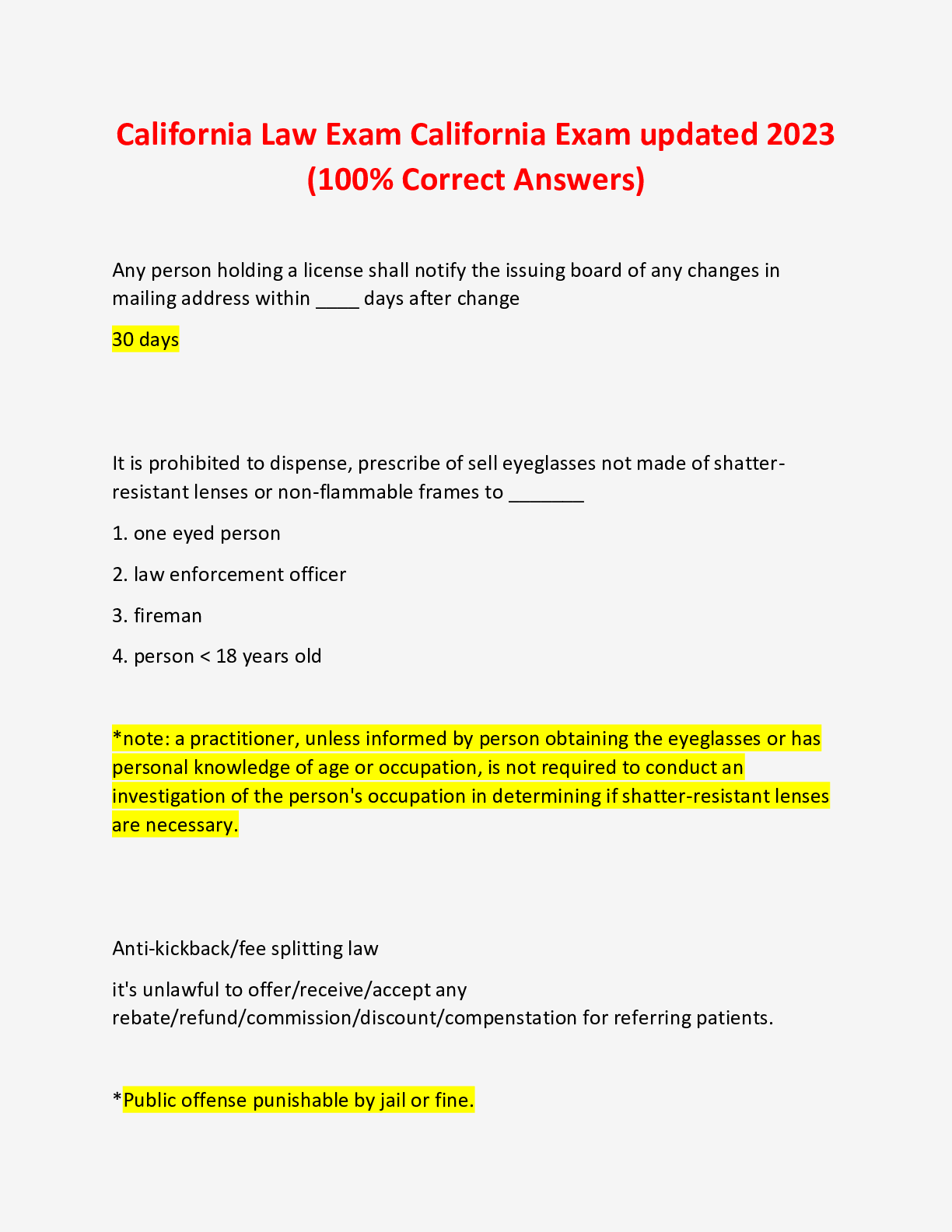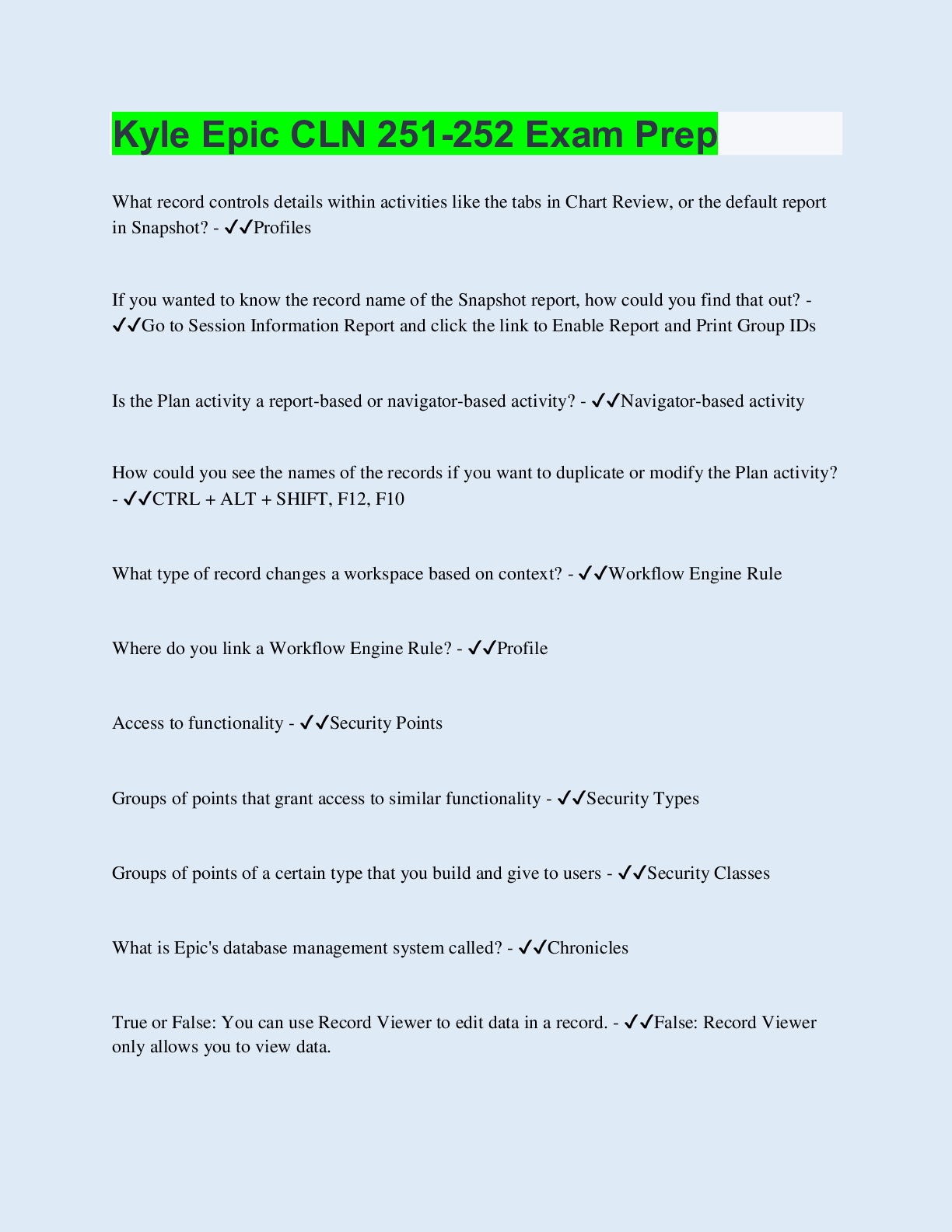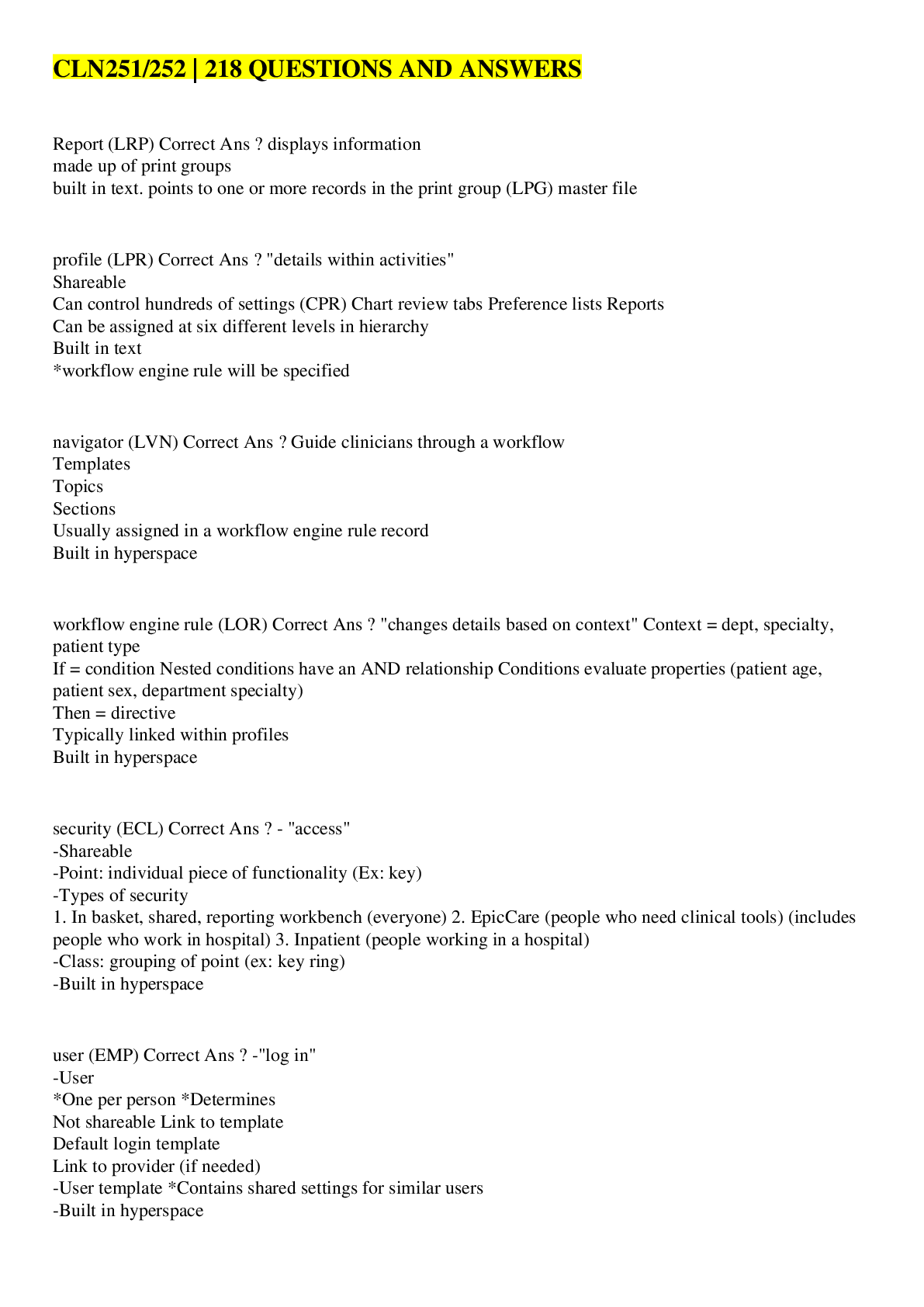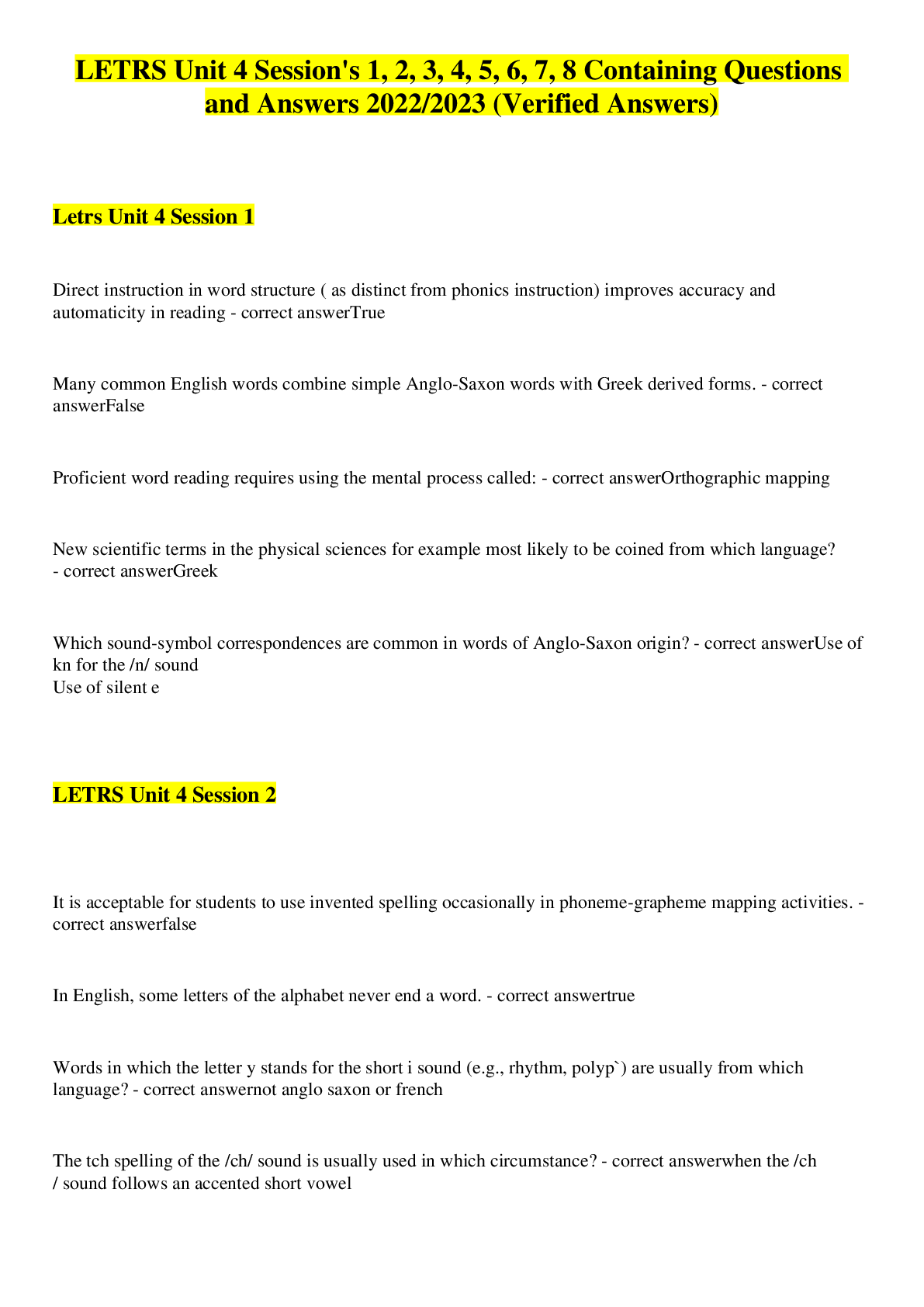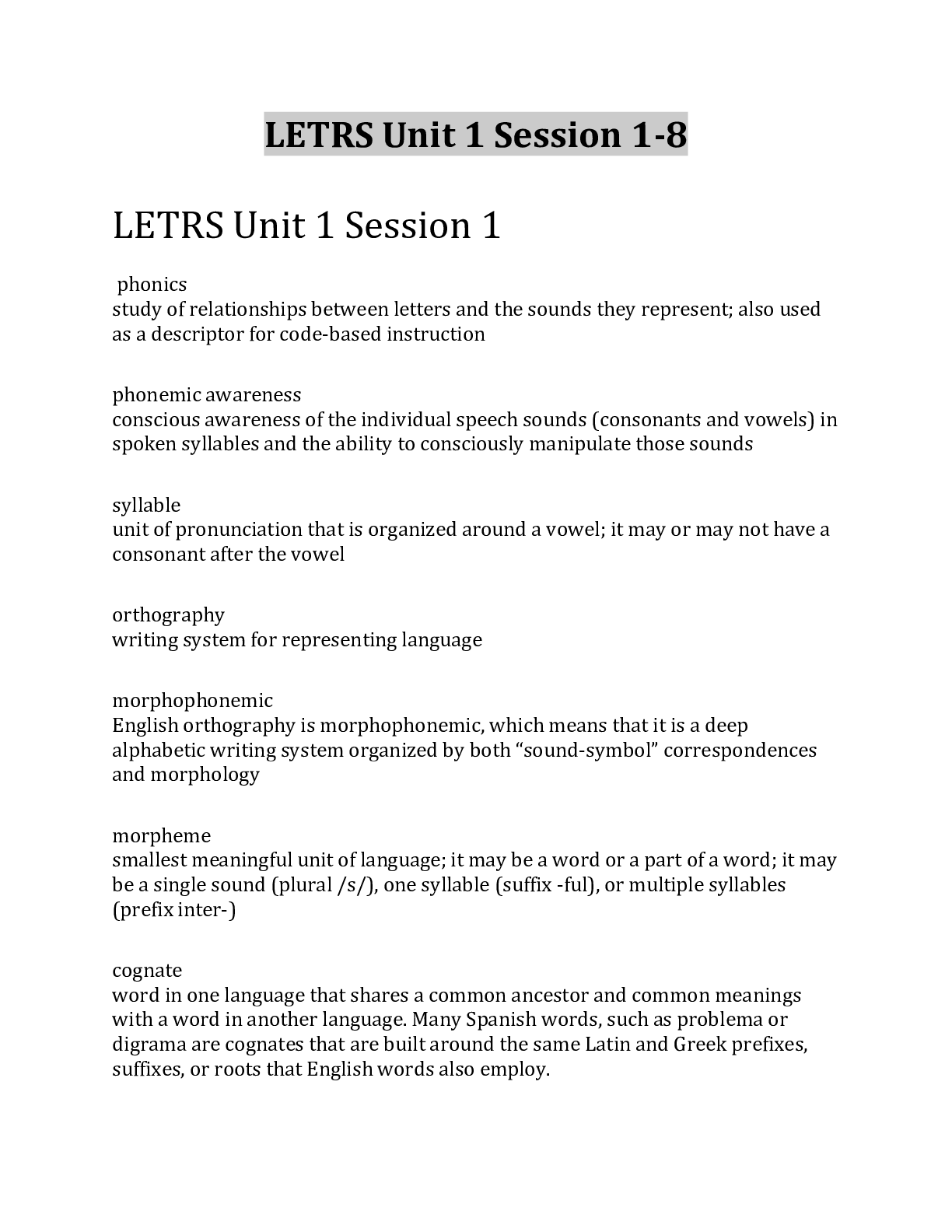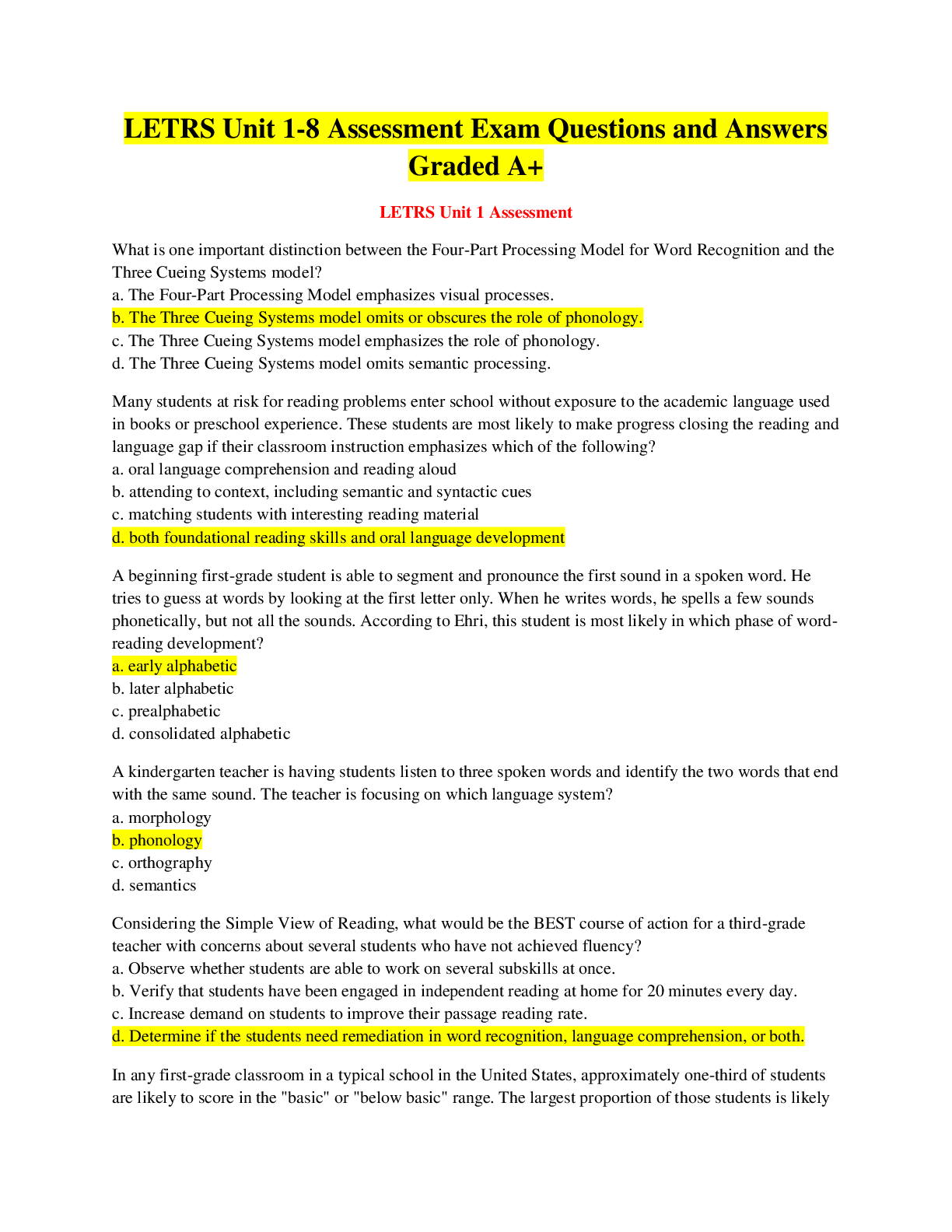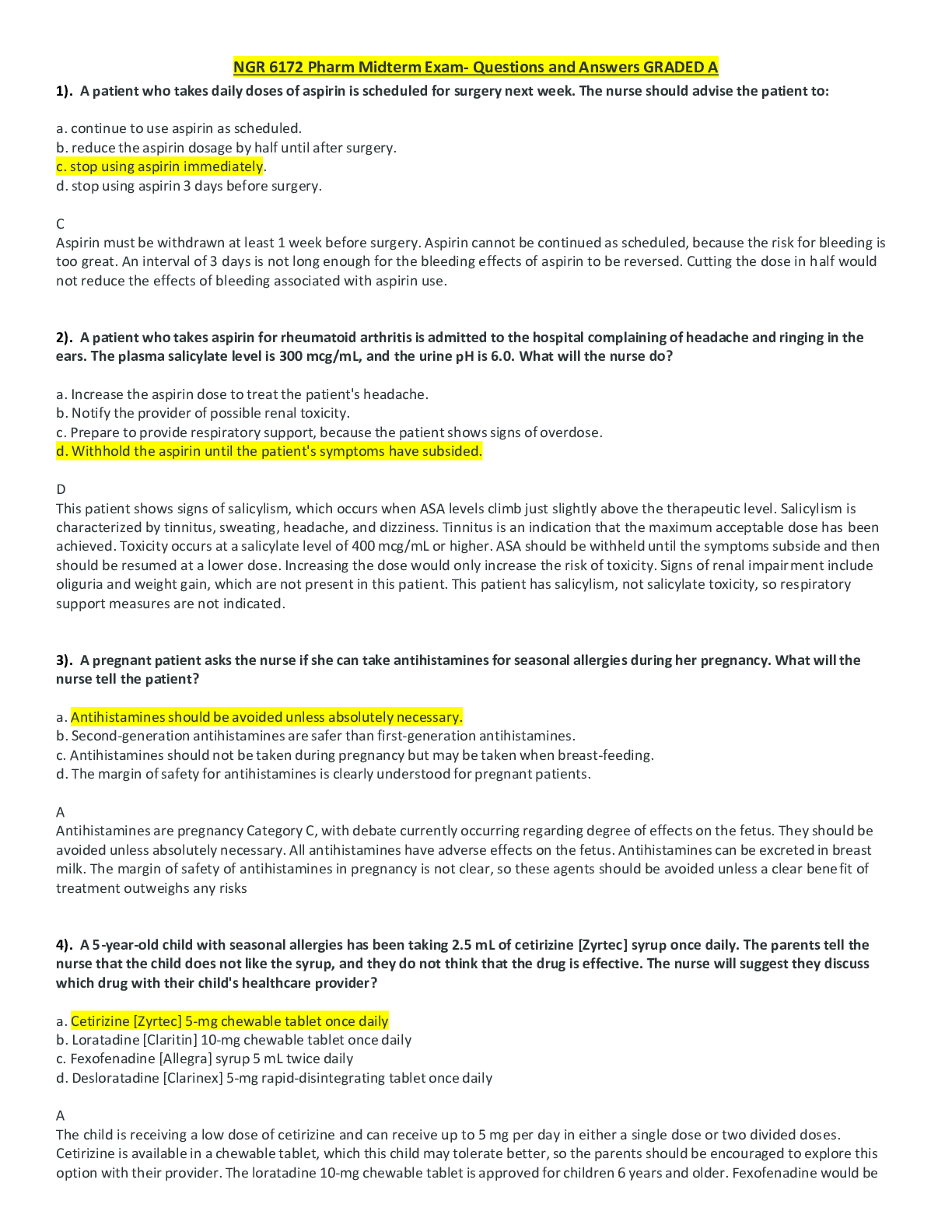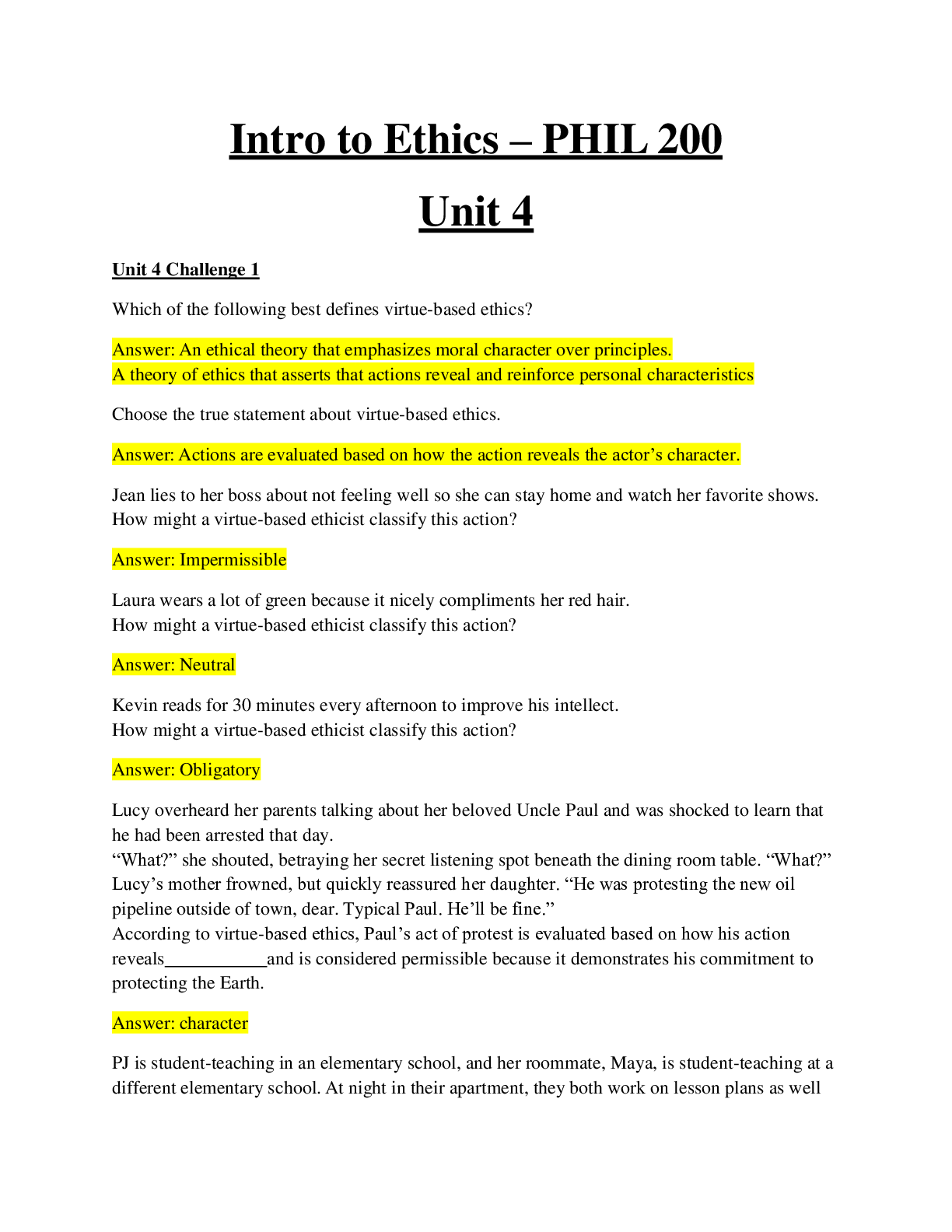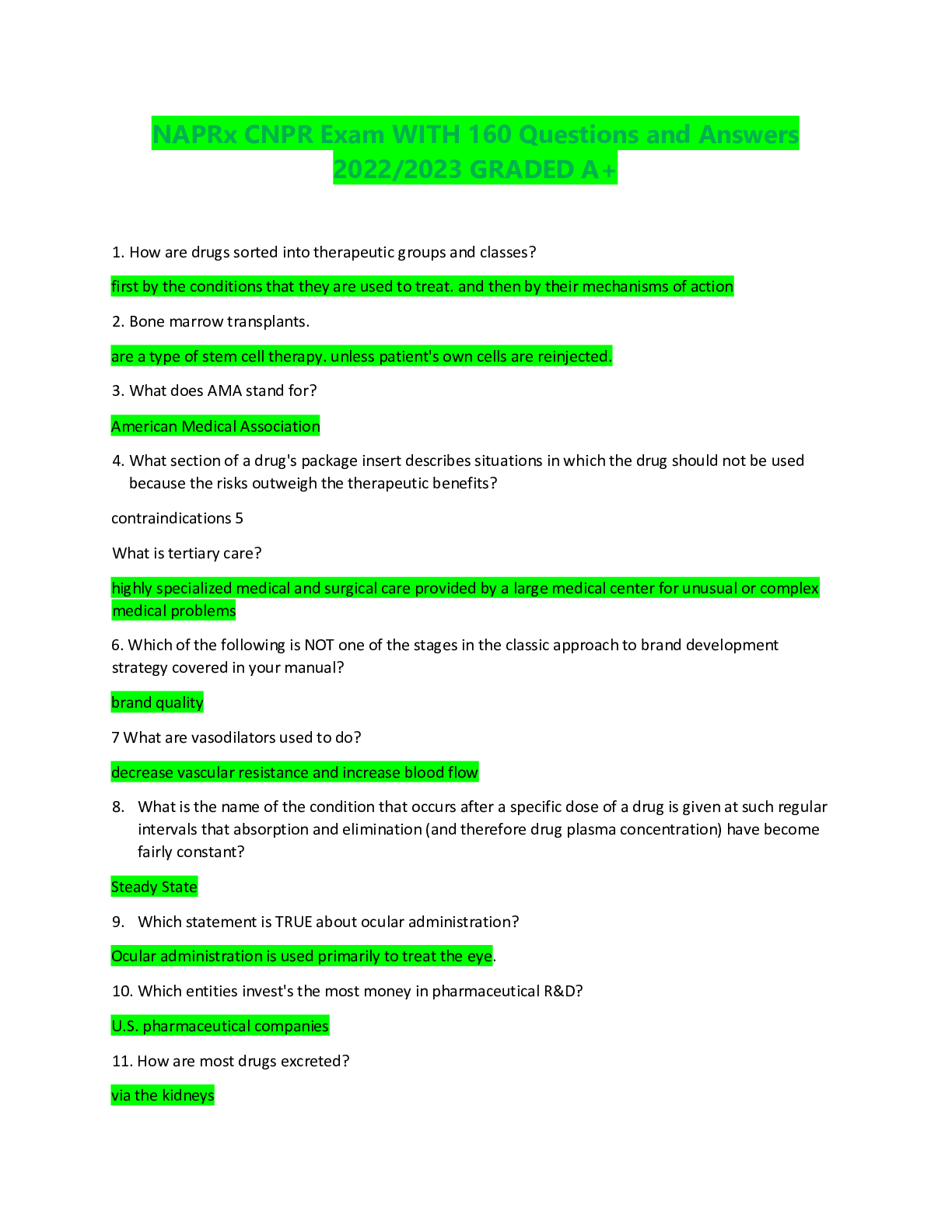Micro Biology > EXAM > (SOLVED) BIOD 171 Microbiology lab exams 1-9 Questions and Answer solutions | Portage Learning (All)
(SOLVED) BIOD 171 Microbiology lab exams 1-9 Questions and Answer solutions | Portage Learning
Document Content and Description Below
BIOD 171 Microbiology lab exams 1-9 LAB 1 Answer the following questions 1. What three elements are used in an autoclave to sterilize equipment? heat, pressure, and steam 2. What is th... e minimum temperature an autoclave must be set at to achieve sterile condition? 125°C 3. If you are working in a lab in which an autoclave is not available, and you are pressed for time, which would you chose to best sterilize your equipment? Hot steam or hot air? Explain why you chose your answer. Hot steam is the best choice as you can achieve a sterile environment in a matter of minutes whereas hot air will take several hours to achieve the same effect. 4. What type of incubator is pictured below? Fixed incubator Answer Key Answer the following questions. 1. You are a lab instructor and Sally Miller has turned in her lab notebook for you to grade the lab experiment #1 on lab safety. Based upon what was covered in the lab video, how should Sally have entitled her experiment? SM01 Lab Safety 2. You arrive to your first day of work at a new lab. You are taking over for someone who took a new job at another lab. Your boss informs you that because of time restraints, this person did not exactly follow the experimental protocol. In order to proceed, you must know what he did differently. (1) According to the lab lecture, under what section of his notebook would you look to find the experimental steps? (2) As changes to the experimental steps were made, what are these differences called and how should it appear in the lab notebook? (1) Procedure—this is where the steps for the experimental protocol are recorded. (2) Deviations. All deviations should be written in red to immediately bring attention to the changes in the protocol. LAB 2 1. Identify the part of the microscope indicated by the arrow. Oculars (or eyepiece) 2. Identify the part of the microscope indicated by the arrow. Objectives (or objective lens) 3. Identify the part of the microscope indicated by the arrow. Course focus 1. You are about to study a bacterial sample under a light microscope. You look into the oculars and see two circles. What adjustments need to be made? Compress or expand the oculars until a single circle can be seen while using both eyes simultaneously. 2. What 2 parts of the microscope contributes to the total magnification to your sample? Objective and oculars (eyepiece) 3. As you looking through the microscope you wish to dim (or limit) the amount of light entering into the eyepiece—what component of the microscope other than the light source itself can be adjusted to make these modifications? Diaphragm 1. What objective power is best suited if you are uncertain what the sample is and where to begin? 4x (or lowest power objective) 2. You are viewing a sample of bacteria that is 3 mm in diameter through a 40x objective lens. The eyepiece has a magnification power of 10x. What size will the sample appear through the eyepiece? 1200 mm in diameter (or 400x’s larger) 3. Based on the microscope shown in the lab lecture, which objectives would NOT require placing oil on the slide? 4x, 10x and 40x LAB 3 1. List the 4 main steps used to prepare a DRY mount and indicate which step is optional. 1 – Clean slide 2 – Circle area on slide for specimen placement (OPTIONAL) 3 – Apply organism to slide 4 – Air dry at room temperature 2. Why is it important to first clean your slide before applying your sample? You must first remove any unwanted contaminants from the slide otherwise it may be difficult to distinguish between the pathogen of interest and a contaminant. 3. When performing a wet mount technique, what is the advantage of using a wax or hydrophobic pen? Creating a hydrophobic barrier (the circle) helps to keep the water within the circle so it does not spill off of the slide. 4. What dye do Gram-positive bacteria primarily retain? Crystal violet 1. Why are Gram-positive bacteria able to retain the crystal violet dye? They contain a thick peptidoglycan layer in their cell wall that readily retains the dye. 2. Identify the Gram status (positive or negative) and shape of the bacteria pictured below. Gram-Negative; Bacillus (rod) 3. An acid-fast stain is most commonly used to identify what type of bacterium? What is the name of the primary dye used in this technique? Mycobacterium; carbolfuchsin dye 4. Why do bacteria repel the dye nigrosin? Nigrosin is a negatively charged dye. The membranes of most cells are also negatively charged. The membrane will repel the dye not allowing it to be absorbed. 1. What is one disadvantage of heat fixing a sample? The heat fixing procedure kills the specimen. This also prevents any observations on motility and enzymatic properties. 2. What is the proper way to dispose of all materials used during the lab? All materials must be place in a biohazardous waste bag and placed into an autoclave for sterilization. 3. What are the Gram status, shape and identification of organism #2 from the Gram stain procedure? Gram-negative; Bacillus (rod); E. Coli 4. What are the Gram status, shape and identification of organism #5 from the Gram stain procedure? Gram-positive; Cocci (spherical) chain; Streptococcus LAB 4 1. What type of media is best used to eliminate certain bacteria from within a mixed culture? Selective media 2. According the lab module, what type of agar plate is the most commonly used nutrient agar? What color is it? LB agar; Light (or pale) yellow 3. What was the name of the selective agar plate (shown below) that is similar to a blood agar plate? MacConkey agar 1. What type of bacteria does MacConkey agar select for? Gram-negative bacteria 2. Sorbitol MacConkey (SMAC) agar is: A. Selective media B. Differential media C. Selective and differential media D. None of the above C 3. What pathogen is best identified using a SMAC agar? E coli O157:H7. SMAC agar specifically differentiates between non-pathogenic E coli and the pathogenic E coli strain O157:H7. 4. What is the purpose of doing a 4-phase dilution streak? The purpose of a 4-phase dilution streak is to isolate individual bacterial colonies. 5. If you were required to grow 4 types of bacteria on a single agar plate without cross contaminating the samples, what method would you use? Quadrant growth method 1. Based on the 4-phase dilution streaking experiment, in what phase were bacterial isolates (colonies) observed? Individual colonies were observed within Phase 3. 2. Identify the plating method (below) as demonstrated in the lab. Quadrant growth 3. Identify the organism growing on the TOP half of the agar and describe the observed hemolytic properties. Staph Aureus; Beta hemolysis is observed based on the zones of clearing within the red agar. 4. Would you expect to see a color change when pseudomonas is streaked onto an EMB agar plate? Explain your answer. No. There would not be a color change because pseudomonas does not ferment lactose. Lab 5 1. The Kirby-Bauer method for examining antibiotic sensitivity is also known as what? The Standardized Disc Susceptibility Test 2. True or False. The antibiotic discs are placed onto the LB agar plate before spreading the bacterial culture on the plate. False. The antibiotic discs are place onto the plate AFTER the culture has been spread. 3. When performing the Kirby-Bauer method the areas of clearing surrounding an antibiotic disc after an overnight incubation are known as what? Zones of Inhibition. 1. Why was an LB agar plate used to test the Staph culture as opposed to a selective/differential agar that only grows Staph? LB agar is used as it simply provides the nutritional requirements to encourage bacterial growth. Since the results of the Kirby Bauer method is directly based on bacterial growth patterns, no other selective or differential additives should be present that may hinder or inhibit the samples growth. 2. What unit of measurement is used when determining the size of the zones of inhibition? A. Centimeters B. Micrometer C. Millimeters D. Meters C 3. True or False. In order to maintain proper spacing the antibiotic discs should be place around the edge of the plate. False. The disc should be placed approximately a fingers width from the edge so that a uniform zone of inhibition can be seen around the entire disc. 1. Given the following image, determine whether the bacterial sample is resistant or susceptible to the following antibiotics. A—24mm (because radius is given) Susceptible B—9mm Susceptible, despite small zone of inhibition. C—14mm Resistant LAB 6 1. True or False. The presence of cytochrome C is often associated with aerobic bacteria. True 2. Which STD is most often identified using the Oxidase test? Gonorrhea 3. Using the catalase test, a Staphylococcus sample would be: A. Gram (+), Catalase (+) B. Gram (-) Catalase (+) C. Gram (-), Catalase (-) D. Gram (+), Catalase (-) A. Gram-positive, Catalase-positive. 4. True or False. The catalase test is a qualitative and selective assay. False. The catalase test is a qualitative and differential assay. 1. Fibrin is another term for ? blood clots 2. Once you inoculate the rabbit plasma containing media for the coagulase test, how long do you wait to read the sample results? A. 1-2 hours B. 3-6 hours C. 8-10 hours D. 12-14 hours D. 12-14 hours which is the equivalent of an overnight incubation. 3. What specific bacterium was mentioned to be coagulase positive and resistant to antibiotics? Staph aureus. 4. The hydrolysis of triglycerides on a spirit blue agar plate most closely resembles that of hemolysis on a blood agar plate. A. Gamma B. Beta C. Alpha D. None of the above. B. Beta. 5. As stated in the lab video, an example of a lipase-positive bacterium is: A. Staph aureus B. Pseudomonas C. Bacillus subtilis D. Streptococcus C. Bacillus subtilis An unknown bacterium (Sample A) was tested using several of the rapid, qualitative tests described within this lab lecture. Using the images of the results below indicate the lab results for each test (1- 3) as either positive or negative, then using the decision tree identify the unknown bacterium by the corresponding letter. The unknown sample is: Oxidase-positive (aerobic), catalase negative and coagulase- positive, which on the decision tree, corresponds with the letter C. LAB 7 1. A biochemical test used to identify whether or not a microorganism can breakdown tryptophan is called the test. Indole 2. What color would you expect to see on the 4-quadrant enzymatic test card if a microorganism was unable to breakdown tryptophan? Yellow. The microorganism would be classified as indole negative. 3. Name one advantage that the ability to breakdown tryptophan brings to a microorganism. An increased resistance to drugs/medications OR an increased ability to survive harsh environments—often seen via spore formation. 1. What three sugars are used in the Triple Sugar Iron (TSI) agar? Glucose, lactose and sucrose. 2. What color is a TSI agar slant containing the negative control? Why? Red. A TSI agar slant contains 3 sugars and a red pH indicator dye. If none of the sugars have been fermented (negative control) the pH does not change and the indicator dye stays red. Only when the sugars present have been fermented does the pH indicator dye turn from red to yellow. 3. Enteric bacteria are often found where? Give an example of one. Enteric bacteria around found in either the intestines or gut. Examples given in the video were either Salmonella or Shigella. 1. According to the lab module, which 5 wells of the API strip should be layered with mineral oil? ADH, LDC, ODC, H2S and URE 2. How many milliliters of water were added to the tray prior to incubating the strip at 37C overnight? 5 mL 3. What is the main advantage of using the API test? The API test allows for rapid characterization by simultaneously assessing 20 different enzymatic properties of a given microbe. 4. Enter the API Code for S1 and S2 from the lab here: S1: 5044550 S2: 2206002 API ANSWER KEY LAB 8 1. The word ‘antigen’ is actually a combination for what two words? Antibody-generating 2. For the ELISA assay depicted below, what do the arrows indicate? The arrows indicate the wash steps. 3. What would happen in terms of the colorimetric readout if you forgot to do the wash step after Step D (above)? All of the wells would have a dark color. The intensity of the readout is dependent upon the amount of the labeled secondary antibody present in the well. Since the unbound secondary antibody was not washed away, all wells would react equally. 1. In a Western blot are separated based on its size. proteins 2. When setting up a western blot, what is the purpose of the blocking step post-transfer? Blocking prevents non-specific binding of the antibody—you only want the antibody to bind to its specific target. 3. When developing a western blot what two factors influence the intensity of the band? Both the amount of protein loaded as well as the duration (time) of development is directly proportional to band intensity. 4. Identify (specific name) given to the region of the western blot indicated by the arrow. The arrow is pointing to the dye front. 1. What is the common name for agglutination? Clumping 2. In the wet lab portion of the video, what pathogen was the agglutination assay specifically designed to test for? Choose all that apply. A. E coli B. Salmonella C. Staph D. Strep C. Staph 3. What was the purpose of the first quadrant of the agglutination assay containing only the reagent? The first quadrant served as the reagent only negative control—you want to ensure the reagent by itself does not clump but rather requires the presence of Staph. 4. Based on the image below, which row (A or B) is negative for agglutination? Row A is negative for agglutination. 5. A patient with type O blood is sent to the lab for a blood-clotting assessment. Since type O blood contains no antigens, which quadrant (#1-6) best depicts the result you would expect to see once the assay is complete? Quadrant 6 shows no signs of agglutination, which is only possible in the presence of antigens. Since Type O blood has no antigens, no clumping will occur during the test. Note: Quadrant 2 was stated to have clumping (albeit minimal) during the wet lab and is thus not an acceptable answer. LAB 9 Using the observations made and recorded from PL09 Unknown Pathogen, complete the results sections accordingly. 1. Given Culture A and Culture B were accidentally mixed, what observations were made from the Gram stain (shown below)? Gram-positive cocci (spherical) clusters and Gram-negative bacillus (rods) were observed. 2. Given the results from a MacConkey agar plate shown below, what is the shape of Culture A? Culture B? MacConkey agar is selective for Gram-negative bacteria. Thus, Culture A must be Gram- positive as no growth was observed. Coupled to the results of the gram stain, Culture A (Gram-positive) must be the cocci. Culture B must be Gram-negative (growth observed) and this correlates to the bacillus or rod-shaped bacteria. 3. The hemolytic properties of both cultures were next examined by streaking each culture on a blood agar plate (shown below). What is the hemolytic status of Culture A? Culture B? Culture A exhibits beta hemolysis as defined by the region of clearing around the growing bacterial streak. Culture B exhibits gamma-hemolysis (non-hemolytic) as indicated by the white colonies growing on the still red agar. Using the observations made and recorded from PL09 Unknown Pathogen, complete the results sections accordingly. 1. Culture A and Culture B were streaked onto EMB plates. What does this tell you about each of the cultures? Describe your observations. EMB agar is both selective and differential media. EMB restricts Gram-positive and as such this again confirms Culture A is Gram-positive. Culture B clearly grew on the EMB plate, further confirming it is Gram-negative. A green metallic sheen was also observed which immediately suggests Culture B is E. coli. 2. Culture A and Culture B were assessed via the catalase test as shown below. State your observations for each culture. Culture A and B were both catalase positive meaning both are able to breakdown hydrogen peroxide (damages cellular integrity) into harmless hydrogen and water molecules. 3. Culture A and Culture B were assessed via the oxidase test as shown below. State your observations for each culture. Culture A and B were both oxidase negative. This suggests both bacteria are anaerobic (or at the very least facultative). The top left panel is simply the negative control, while the top right quadrant is the positive control. 4. Culture A and Culture B were assessed via the coagulase test as shown below. State your observations for each culture. Culture A is coagulase positive. The inverted tube showcases the clotting/hardening effect. This strongly suggests Culture A is Staph aureus as shown in the Lab#6 coagulase test. Culture B is coagulase negative. The tube could not be inverted as the culture was entirely in liquid form. 5. Below state your conclusions on the identifications of Culture A and Culture B based on your summary of results. Culture A: Staph aureus Gram-positive cocci Beta hemolytic Catalase positive Oxidase negative Coagulase positive Culture B: E. coli Gram-negative bacillus Red colonies on Mac; lac+ Gamma hemolytic Metallic green on EMB Catalase positive Oxidase negative Coagulase negative [Show More]
Last updated: 1 year ago
Preview 1 out of 22 pages
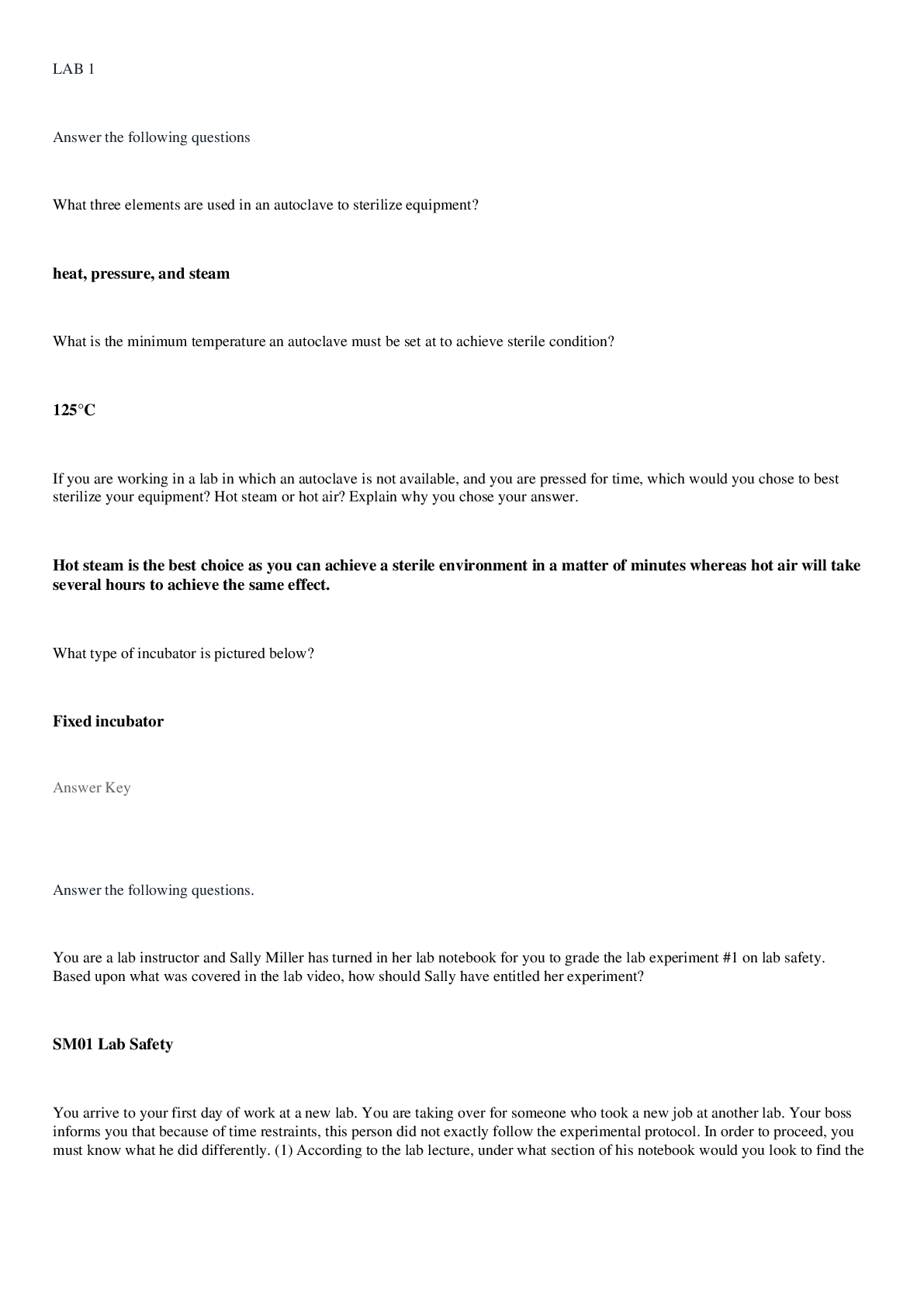
Reviews( 0 )
Document information
Connected school, study & course
About the document
Uploaded On
Aug 11, 2022
Number of pages
22
Written in
Additional information
This document has been written for:
Uploaded
Aug 11, 2022
Downloads
0
Views
49

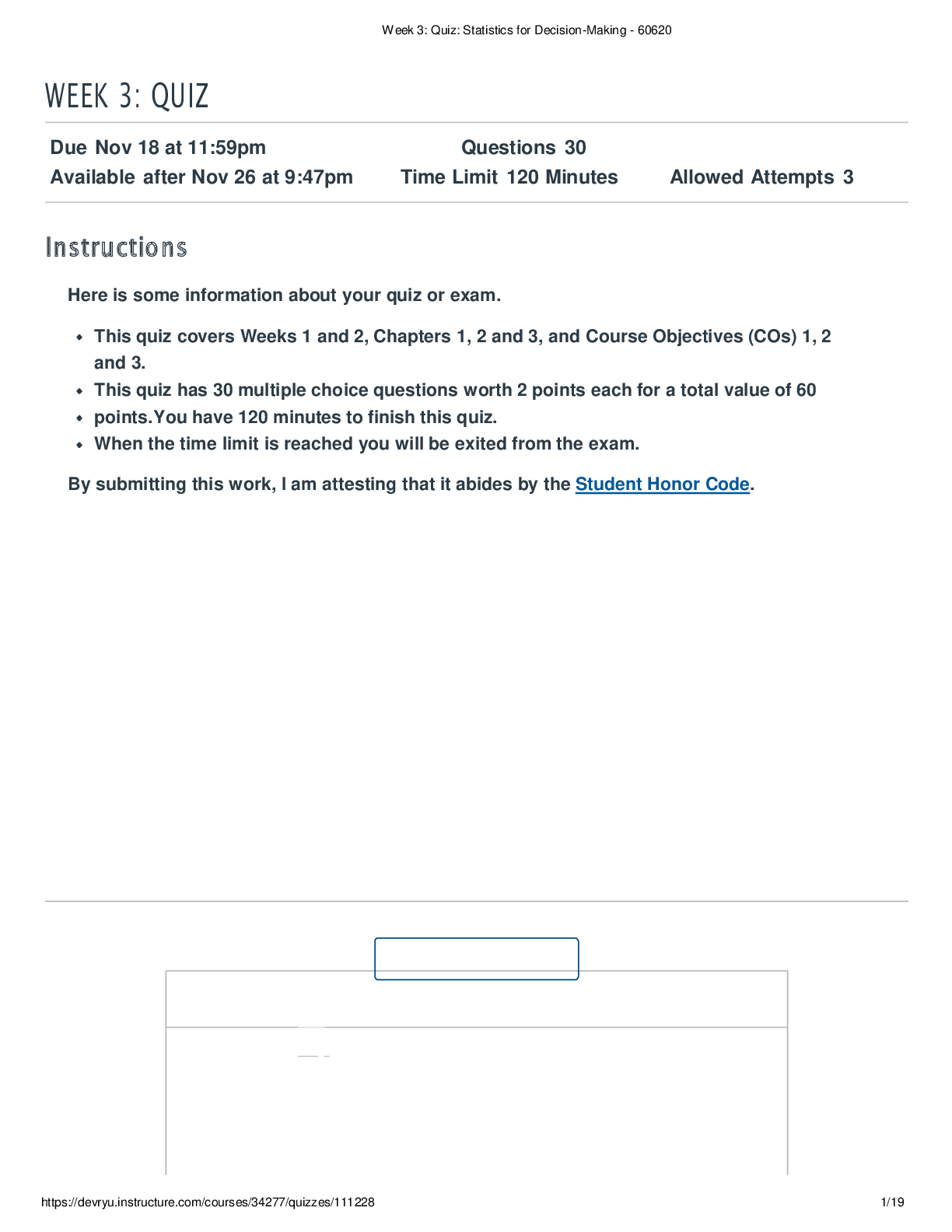

.png)










